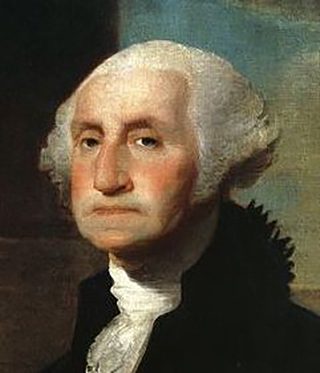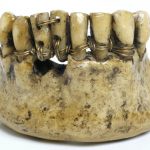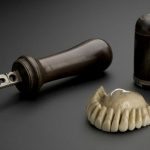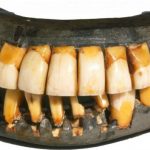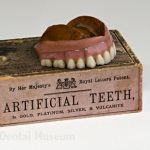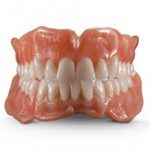Looks a bit glum, doesn’t he? When compared to other portraits of Washington, you can see that his lower jaw is protruding unnaturally and the muscles around his mouth appear to be engaging in an effort to keep his lips closed. This has been attributed to the spring- loaded dentures he was wearing at the time. If he didn’t purse his lips tight, his gnashers were liable to leap out of his mouth!
Needless to say, old George was very unhappy with his dentist. There are fantastic records of the letters the disgruntled president sent his dentist, specifying what adjustments he felt were required, along with the teeth in question.
The oldest known dentures are from the 7th Century BCE when Etruscans used gold wire to fasten human or animal teeth to remaining teeth in the mouth. It’s possible that ancient Egyptians were using a similar method as far back as 1500BCE.
These were partial dentures, meaning they only replaced some teeth. The first full dentures weren’t fabricated until 16th Century Japan. Using beeswax to make a mould of the mouth, they meticulously carved Japanese boxwood to fit around the gums. This advanced technique did not hit Europe for another two centuries. At around the same time, the Japanese were crafting their beautiful wooden dentures, Elizabeth 1st of England resorted to stuffing the gaps in her smile with cloth when she went out in public. Towards the end of her life courtiers complained they had trouble understanding her, so bad were her teeth.
Mexicans solved the problem of a gappy smile using animal teeth, usually that of a wolf, by simply inserting their lupine fang into the socket left behind by the missing one, without needing to wire it to existing teeth. This was more like a prototype of a dental implant than a denture because the gum healed around the new tooth and held it in place to some extent.
Most American dentures were made of ivory, rather than wood, although as the ivory aged it developed hairline fractures that would absorb food stains, giving them the appearance of wood. This is likely to be the origin of the persistent myth that George Washington’s teeth were wooden. His were, in fact, a combination of hippopotamus tusk base inset with teeth from humans, horses and donkeys.
The Napoleonic Wars led to a glut of spare teeth entering the market. People would scour the battlefields and remove the teeth from dead soldiers then sell them to the English in barrel loads. These would be set in ivory using metal rivets and were nicknamed Waterloo Teeth.
Porcelain was first used to fabricate dentures by Alexis Duchateau in England in the late 18th century, using porcelain paste obtained from Wedgwood. He was a little too successful, as the porcelain teeth appeared unnaturally white and were obviously false. By 1820 Claudius Ash was using gold underneath the porcelain to give the teeth a more natural yellow hue. Replete with finely crafted swivels and springs, this goldsmith’s work signalled a huge improvement in the fit and function of dentures. Ash then went on to develop Vulcanite, or hardened rubber denture bases. The Vulcanite fit well and was cheaper than an all- porcelain denture, however the porcelain teeth still chipped easily.
Enter, acrylic resin. This is the material used in modern dentures, and has been in use since the beginning of the 20th Century. It is durable, comfortable and realistic looking. And a lot more hygienic than dead soldiers’ teeth.

